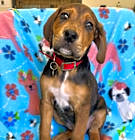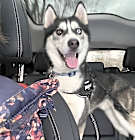Pitskies range in size, depending on the size of their parents. On average, Pitskies are medium-to-large dogs who weigh between 35 and 75 pounds and are 16 to 25 inches tall. A Pit Bull / Husky mix puppy will reach their full-grown size by the time they are a year old but may take up to 18 months to reach their adult weight.
Pitsky
Breed Type: Crossbreed
Common nicknames: Husky Pit
Coat: Smooth, double
Hypoallergenic: No, they will likely trigger allergies.
Temperament: Friendly, energetic, independent, affectionate
Life expectancy: 10-15 years
Color & patterns: Fawn

Pitskies are friendly, gentle, sweet-natured companions. The mixed-breed dog is a cross between an American Pit Bull Terrier and either an Alaskan or Siberian Husky. The parent breeds are both working dogs, and Pitskies retain their love of work, which means they are active, energetic dogs who require a lot of regular exercise and mental stimulation. The Pit Bull / Husky Mix, known as the Pitsky or the Husky / Pit, loves taking long walks with their favorite people. They are highly trainable (albeit slightly stubborn) dogs who make excellent family dogs. FYI: The term Pit Bull doesn’t refer to a single breed; but rather, a group of breeds (a.k.a. Bully breeds) which includes the American Pit Bull Terrier.
Pitsky characteristics
Learn about about Pitsky basics like their fur colors, shedding levels, how much grooming they need, and other Pitsky facts.
Average height
16-25 inches (40.6-63.5cm)
Average weight
35-75 pounds (15.9-34.0 kg)
Average lifespan
10-15 years
Exercise needs
Grooming needs
Full-grown size
Good with cats
Good with kids
Training aptitude
What colors do Pitskies come in?
Pitskies can have solid-colored coats or coats in almost any combination of colors of their parent breeds. The better question is, what colors do Pitskies not come in? Huskies can be solid white, gray, black, or bicolor black and tan, gray and white, black and white, or red and white, while Pit Bulls can be white, gray, brown, black, bicolor, and tricolor combinations of those colors, including brindle.
What coat type do Pitskies have?
Because of the differences between breeds, Pitskies might inherit the smooth coat of the Pit Bull or the Husky’s thick fur and undercoat. Pitskies who look more like their Husky parents will have double coats with soft undercoats and medium-length outer coats that have a shaggy appearance, while those who look more like Pit Bulls will have short, smooth coats.
Do Pitskies shed?
Yes, Pitskies are moderate to high shedders. Smooth-coat Pitskies are low-maintenance and need minimal brushing, while long-coat Pitskies require regular grooming to keep their fur from matting.
What is the lifespan of a Pitsky?
Pitskies typically live 10 to 15 years. The lifespan of a Pitsky is influenced by a combination of genetic factors from both parent breeds.
When do Pitskies stop growing?
Pitskies stop growing between 10 and 12 months old. Adequate nutrition is essential for healthy growth and development. Providing a balanced diet with all the necessary nutrients will help a Pitsky reach their full potential size.
Pitsky history
Learn about where this Pitsky came from!
Where are Pitskies from?
Pitskies are from the United States and were bred mainly for their cool looks and companionship.
What do Pitskies look like?
Pitskies can vary in appearance. They may have the patterns and markings of a Husky, with the shorter coat of a Pit Bull, or, depending on their parents’ genes, these pups might look like blue-eyed Pit Bulls. They could also have fur coats that are thicker than a Pittie’s but not as thick as a Husky’s.
Pitsky temperament
Learn about about the Pitsky temperament and how well they fit into your lifestyle, home environment, and family.
Are Pitskies good dogs?
Yes, Pitskies are good dogs. Pitskies might look (and sound) like fierce guard dogs, but these dogs are lovers, not fighters. Pitskies inherit the friendliness and pack mentality from their parent breeds, making them loving, affectionate, gregarious, extremely friendly companions who are devoted to their families.
Are Pitskies high-energy dogs?
Yes, Pitskies are high-energy dogs. In addition to being outgoing, confident, even-tempered, and sweet, Pitskies are very active. These dogs enjoy outdoor activities, especially when it means spending extra time with their families. Because of their independent nature, they may not be suited for more structured sports, such as agility and rally.
Do Pitskies bark much?
Pitskies like to sing the songs of their people. Huskies have a distinctive howl, and the trait can be passed on to Pitskies, so these dogs might howl, whine, and “woo” like Alaskan Huskies. They may also bark long and loud, like Pit Bulls. Even though Pitskies are a vocal breed, training and providing lots of exercise to burn off excess energy can discourage them from barking.
Are Pitskies good family dogs?
Yes. Pitskies make great family dogs because they love people and love to play. These pets would do best in an active family, as they need enough exercise, mental stimulation, and companionship to be on their best behavior.
Can a Pitsky be left alone?
Yes, Pitskies can be left alone, but because these pups are people-oriented, they may be prone to separation anxiety and destructive behavior if left alone for long periods of time.
Are Pitskies easy to train?
Yes. Pitskies are smart and eager to please, which helps with obedience training. Focus on positive reinforcement and rewards to teach them basic commands and new tricks. Pitskies can also be stubborn; offer treats, toys, and praise to keep them from getting distracted and refocus their attention on training. Just keep in mind that training any dog takes substantial time and effort, regardless of breed.
Do Pitskies get along with cats?
Pitskies can get along with cats, but don’t expect them to be immediate BFFs. The high-energy breed can be rambunctious with other, smaller animals. With proper training and early socialization, teaching Pitskies the boundaries needed to live harmoniously with cats is possible.
Pitsky health
Learn about about the Pitsky health outlook and what diseases they may be prone to at various stages of their life.
Are Pitskies healthy?
Yes, Pitskies are a generally healthy breed. But Pitskies can inherit some of the health issues prevalent in their parent breeds, including congenital heart defects, hypothyroidism, and skin problems. Other potential health problems to discuss with your vet include the following:
Patellar luxation: Patellar luxation is a common problem in many dog breeds, including both Pit Bulls and Huskies. When slight abnormalities in the kneecap cause it to be displaced in the knee joint, dogs experience pain and occasional lameness.
Hip dysplasia: Pitskies have a higher risk of developing hip dysplasia, a skeletal disease in which the joint has grown abnormally or is misshapen, resulting in pain, lameness, and secondary osteoarthritis.
It’s important to remember that even though this breed might have an increased risk for certain health conditions, that doesn’t mean they will develop them. Mixed-breed dogs are often healthier than purebred dogs because of greater genetic diversity. Your veterinarian can help you watch for health problems with regular checkups.
Are Pitskies hypoallergenic?
No, Pitskies are not hypoallergenic. They inherit their coat from both parent breeds, which means they produce dander moderately. Because Pitskies are moderate-to-high shedders, they aren’t considered a hypoallergenic breed, so they’re not a good match for people with allergies.
Find Pitsky puppies near you
Adopting a Pitsky
We don't see any Pitskies available for adoption in your exact location or cities near you, but here are some adorable similar breeds in Columbus, OH.

Thursday
Husky Hound (Unknown Type)
Female, 4 mos
Columbus, OH
Not good with dogs
Not good with cats

Rocco
German Shepherd Dog Labrador Retriever
Male, adult
New Albany, OH
Good with dogs
Good with cats
House-trained
Spayed or Neutered
Shots are up-to-date

Sassy
Siberian Husky Hound (Unknown Type)
Female, 2 yrs 4 mos
Lewis Center, OH
Not good with dogs
Not good with cats
Spayed or Neutered

Loki
German Shepherd Dog
Male, 2 yrs 4 mos
Lewis Center, OH
Not good with dogs
Not good with cats
Spayed or Neutered

Dixie
Siberian Husky
Female, 3 yrs 10 mos
Lewis Center, OH
Good with dogs
Not good with cats
House-trained
Spayed or Neutered

DINO
German Shepherd Dog Weimaraner
Male, 5 mos
Columbus, OH
Good with dogs
Not good with cats
House-trained
Spayed or Neutered
Shots are up-to-date

DIXIE
German Shepherd Dog Bernese Mountain Dog
Female, 8 mos
Columbus, OH
Good with dogs
Not good with cats
House-trained
Spayed or Neutered
Shots are up-to-date

Cole
Husky
Male, young
Powell, OH
Good with dogs
Not good with cats
Needs experienced adopter
House-trained
Spayed or Neutered
Shots are up-to-date

Thursday
Husky Hound (Unknown Type)
Female, 4 mos
Columbus, OH
Not good with dogs
Not good with cats

Rocco
German Shepherd Dog Labrador Retriever
Male, adult
New Albany, OH
Good with dogs
Good with cats
House-trained
Spayed or Neutered
Shots are up-to-date

Sassy
Siberian Husky Hound (Unknown Type)
Female, 2 yrs 4 mos
Lewis Center, OH
Not good with dogs
Not good with cats
Spayed or Neutered

Loki
German Shepherd Dog
Male, 2 yrs 4 mos
Lewis Center, OH
Not good with dogs
Not good with cats
Spayed or Neutered

Dixie
Siberian Husky
Female, 3 yrs 10 mos
Lewis Center, OH
Good with dogs
Not good with cats
House-trained
Spayed or Neutered

DINO
German Shepherd Dog Weimaraner
Male, 5 mos
Columbus, OH
Good with dogs
Not good with cats
House-trained
Spayed or Neutered
Shots are up-to-date



